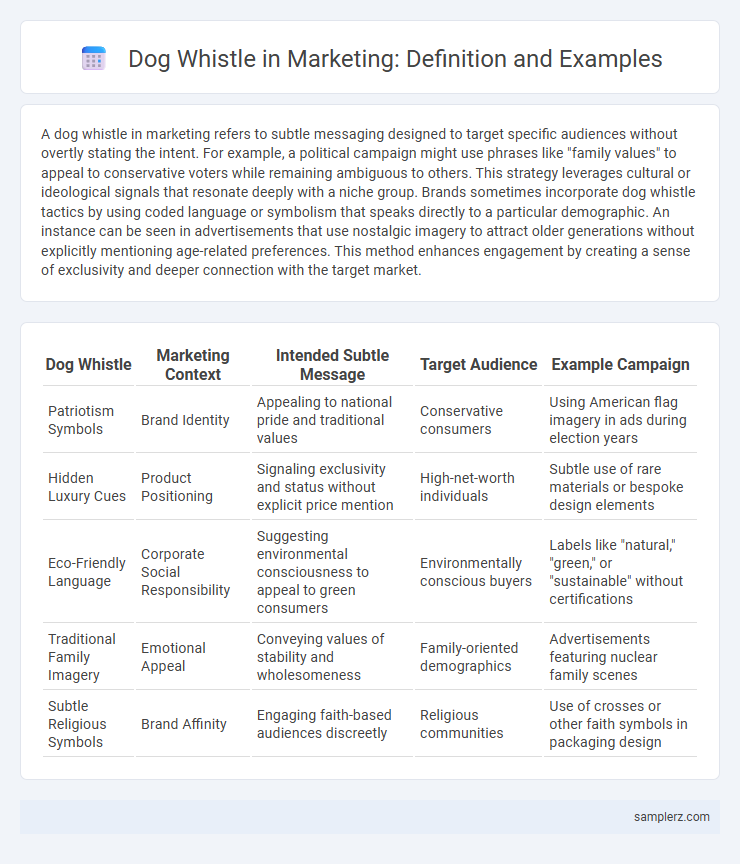A dog whistle in marketing refers to subtle messaging designed to target specific audiences without overtly stating the intent. For example, a political campaign might use phrases like "family values" to appeal to conservative voters while remaining ambiguous to others. This strategy leverages cultural or ideological signals that resonate deeply with a niche group. Brands sometimes incorporate dog whistle tactics by using coded language or symbolism that speaks directly to a particular demographic. An instance can be seen in advertisements that use nostalgic imagery to attract older generations without explicitly mentioning age-related preferences. This method enhances engagement by creating a sense of exclusivity and deeper connection with the target market.
Table of Comparison
| Dog Whistle | Marketing Context | Intended Subtle Message | Target Audience | Example Campaign |
|---|---|---|---|---|
| Patriotism Symbols | Brand Identity | Appealing to national pride and traditional values | Conservative consumers | Using American flag imagery in ads during election years |
| Hidden Luxury Cues | Product Positioning | Signaling exclusivity and status without explicit price mention | High-net-worth individuals | Subtle use of rare materials or bespoke design elements |
| Eco-Friendly Language | Corporate Social Responsibility | Suggesting environmental consciousness to appeal to green consumers | Environmentally conscious buyers | Labels like "natural," "green," or "sustainable" without certifications |
| Traditional Family Imagery | Emotional Appeal | Conveying values of stability and wholesomeness | Family-oriented demographics | Advertisements featuring nuclear family scenes |
| Subtle Religious Symbols | Brand Affinity | Engaging faith-based audiences discreetly | Religious communities | Use of crosses or other faith symbols in packaging design |
Understanding Dog Whistle Tactics in Marketing
Dog whistle tactics in marketing involve using coded language or imagery that resonates with a specific target audience while remaining ambiguous to others. Brands may subtly incorporate cultural references or insider terms that trigger emotional responses in niche groups, enhancing loyalty without overtly alienating broader consumers. Recognizing these strategies helps marketers create focused campaigns that leverage psychological triggers effectively while maintaining broad appeal.
Historical Examples of Dog Whistle Marketing
Historical examples of dog whistle marketing include Richard Nixon's 1968 presidential campaign, which subtly targeted racial tensions with coded language like "law and order." Another case is Ronald Reagan's use of the phrase "welfare queen" during the 1970s and 1980s to appeal to certain voter biases without overtly mentioning race. These instances demonstrate how marketers employ ambiguous messages to resonate with specific audiences while maintaining plausible deniability.
Famous Brands That Have Used Dog Whistles
Nike's use of subtle social justice themes in campaigns like "Just Do It" featuring Colin Kaepernick serves as a prominent example of dog whistle marketing, appealing specifically to progressive audiences while maintaining broad appeal. Coca-Cola's use of nostalgic imagery paired with diverse cultural symbols cleverly signals inclusivity without overtly targeting any single demographic. Similarly, Apple embeds minimalist design and innovation messaging that resonates deeply with tech-savvy consumers, subtly reinforcing brand loyalty through exclusive cues.
Subtle Messaging: Modern Dog Whistle Campaigns
Modern dog whistle campaigns in marketing employ subtle messaging techniques that resonate with specific audience segments without overtly stating the intended message. Brands use coded language, imagery, or symbols to evoke emotional responses or cultural associations that appeal to niche groups. This strategic ambiguity allows marketers to engage targeted consumers while maintaining broad public appeal and avoiding controversy.
The Psychology Behind Dog Whistle Techniques
Dog whistle marketing leverages subtle, coded language that resonates deeply with specific consumer groups by triggering unconscious associations and emotional responses. These messages tap into identity, beliefs, or cultural values without overtly stating controversial or sensitive themes, enhancing brand loyalty and consumer engagement. Understanding this psychological mechanism enables marketers to design campaigns that influence behavior while maintaining plausible deniability.
Ethical Dilemmas in Dog Whistle Marketing
Dog whistle marketing leverages coded language that resonates with specific audience segments while remaining ambiguous or benign to others, raising significant ethical dilemmas about transparency and manipulation. Brands using such tactics risk consumer backlash and damage to their reputation when hidden messages are exposed, undermining trust and brand authenticity. Ethical marketing frameworks emphasize clear communication and respect for all audience groups to avoid perpetuating exclusion or discrimination through covert messaging.
Demographic Targeting Through Dog Whistles
Marketing campaigns often use demographic targeting through dog whistles by embedding subtle cues that resonate specifically with certain age groups or cultural communities without overtly stating the message. For example, a brand might incorporate nostalgic references or colloquial language unique to Millennials to create a sense of exclusivity and connection. These strategic messages increase engagement by appealing to the values, experiences, and identity markers of targeted demographics while maintaining plausible deniability.
Analyzing Real-World Dog Whistle Adverts
Analyzing real-world dog whistle adverts reveals subtle messaging techniques that target specific consumer groups without alienating broader audiences. Brands often embed culturally or politically charged symbols and language, enabling insiders to decode hidden meanings while maintaining surface-level neutrality. This strategic ambiguity boosts engagement among niche markets while preserving mainstream appeal and minimizing backlash.
How to Identify Dog Whistle Marketing Messages
Dog whistle marketing messages use coded language that appeals to specific groups without alienating broader audiences, often relying on ambiguous wording or symbols. Identifying these messages involves analyzing the subtext, cultural references, and demographic targeting embedded within advertisements or slogans. Recognizing patterns such as vague promises, euphemisms, or references that resonate only with niche audiences helps marketers discern when a message serves as a dog whistle.
The Impact of Dog Whistle Marketing on Consumer Behavior
Dog whistle marketing subtly targets specific consumer groups through coded language or symbols that resonate with underlying beliefs or values, significantly influencing purchasing decisions. This technique exploits psychological cues to create a sense of community or identity, driving brand loyalty without overt messaging. Studies show that dog whistle marketing can increase engagement and conversion rates by appealing to subconscious biases and social affiliations.

example of dog whistle in marketing Infographic
 samplerz.com
samplerz.com